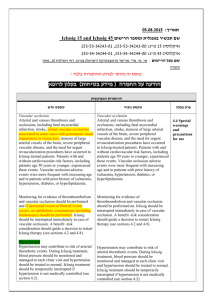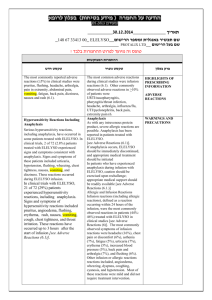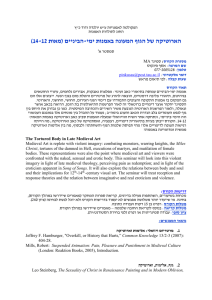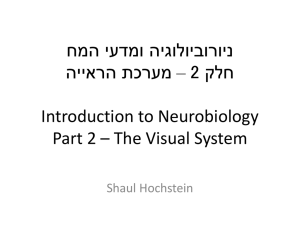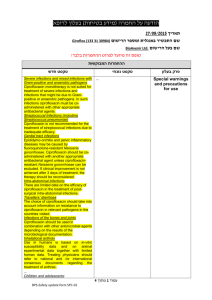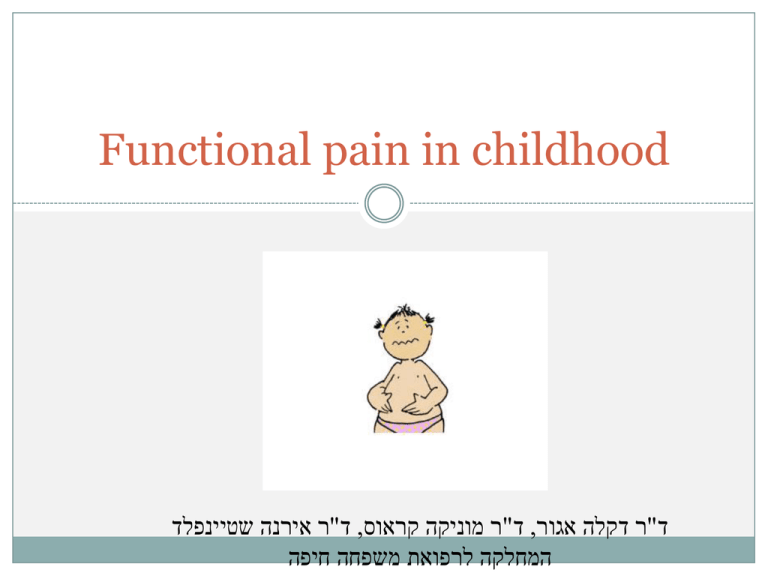
Functional pain in childhood
ד"ר דקלה אגור ,ד"ר מוניקה קראוס ,ד"ר אירנה שטיינפלד
המחלקה לרפואת משפחה חיפה
Girl age 8
ליהי בת ,8כאבי בטן חוזרים מאז ספטמבר .כאבים
הגורמים להחמיץ ימי לימודים .לאחרונה החמרה
בעוצמת הכאב.
שני ההורים עובדים ,עד עכשיו קבלו את כאבי הבטן
כ"תופעה חולפת" אך עתה מבקשים .Reassurance
RAS- What is it?
Recurrent abdominal pain
Apley and Naish 1958: ‘abdo pain that waxes and
wanes, occurs for at least 3 episodes within 3 months
and is severe enough to affect a child’s activities
Other names
Rome 111 criteria: functional dyspepsia
Irritable bowel syndrome
Functional abdominal pain
Abdominal migraine
Prevalence:
Community based studies vary from 0.5 –
19%
Age peaks: 4- 6 years and 7 – 12
Are girls more likely to be affected?
Is it all helicobacter?
Lin et al: 2006, Hepatogastroenterology 53 (72) 883-6 (Taiwan)
135 patients with FAP
All endoscoped, urease breath tests:
43.7% normal
19.3% Esophagitis
13.3 peptic ulcer, 7.4% gastritis.
23.7% had evidence of helicobacter infection
At follow up:
No difference in pain in long term follow up
of those with and those without helicobacter
disease
77% of children continued with same degree
of pain
Causes:
Multifactorial, not understood. Visceral sensation,
alterations in gastrointestinal motility, psychological
factors
Those with bacterial colitis more likely to develop
irritable bowel if infection occurs during stressful life
events
Making the diagnosis confidently
History and examination
Talk to the child
Exacerbating factors?
Relieving factors?
Acknowledge distress
Making the diagnosis confidently
No diagnostic tools BUT
absence of ‘alarm factors’(American Academy : Paediatrics 2005)
Involuntary weight loss
Poor linear growth
GI blood loss
Significant vomiting
Chronic severe diarrhoea
Unexplained fever
FH of inflammatory bowel disease
Which comes first? Anxiety or pain?
No studies could show that stressful life events
significantly differentiate patients with organic and
‘non organic pain’
Headache, anorexia, nausea, constipation or
arthralgia occur as often in children with ‘functional
organic pain’ as those with ‘organic’ pain
Diagnosis: factors likely to be related
Alarm symptoms increase risk of organic disease
Age of child; parental anxiety in first year of life,
parents with GI problems, low SE status
Poor prognosis: if parents ( or paediatrician)
cannot accept functional disorder, parental
attention to childs problems, stressful events,
parental functional problems, sexual abuse
Inconclusive associations:
Helicobacter positivity and positive endomysial ab
(celiac)
Female sex, anxiety, depression, stressful life event
Prognosis: age, female sex, self confidence,
parental coping style
Unlikely to be related:
Pain characteristics, frequency, severity
Depression
Lactose malabsorbtion
Prognosis
Most relatively mild. In a Dutch survey only 2%
required referral
Some studies suggest that may be an increased
incidence in adult irritable bowel syndrome in this
group
Family history of irritable bowel:
Pace et al: World J Gastroenterol: 2006, 12(240) 3874-7
Cohort of 67 children with RAP followed for 5 – 13
years
15/52 (29%) has IBS. this group higher prevalence of
back pain, myalgia, sleep disturbance and FH of
irritable bowel
Management
Validate the child’s experience
Explore the family’s understanding and beliefs of
abdominal pain
May need to do some tests to reassure child and
family – but resist over investigation
Explain the link between emotions and visceral
symptoms – ‘holistic view’
Using a diary
Ask CHILD to keep a pain diary
‘being a detective’
Score 0-5
Review diary with child
Evaluating treatments:
Cognitive behaviour therapy – 3 randomized trials
showed benefit
Peppermint oil – may help
Role of pizotifen (Sanomigran®) ??
More research needed!
Our patient:
High academic achiever
Conscientious and anxious to do well
Scary teacher
Pain worse on needlework lesson days…..
When to investigate
If ‘alarm’ symptoms
If pain not typical – e.g. in the renal area. US may
show obstruction
If there are family health beliefs
And its all food allergy, doc….
Make sure the diet is ‘safe’
Explain the limitation of allergy testing
Discuss celiac disease
Encourage ‘food challenges’ to reintroduce food into
the diet
נועה בת 12ש' מתלוננת בחודשים האחרונים על כאב ראש מצחי
יום יומי .אינה מקיאה ,אין לה חום או תלונות נוספות .מדי פעם
לוקחת אקמול או נורופן להקלת הכאב.
מעברה -בריאה בד"כ
תלמידה טובה ,חברותית ,הולכת לצופים.
לציין -האם סובלת ממיגרנה.
בדיקה גופנית כולל בדיקה נוירולוגית גסה -תקינה .ל.ד120/70 .
בדיקת עיניים תקינה.
מעבדה ??
ס.ד ,.כימיה תקינה.
Epidemiology of Headache
Most common cause of childhood pain
Uncommon before 4 years
Prevalence of all types increases with age
< 10-12 years equal among sexes, male:female 1 : 1
> 10-12 years greater prevalence in girls (1 : 1.5)
most are MIGRAINE or TENSION
remission occurs in 70% of cases ages 9-16 years
1/3 remain headache free after 6 years,
2/3 remain headache free after 16 years
Classification of Headache
PRIMARY = Benign (Migraine, Tension,
Cluster)
exam normal
no papilledema
normal neuroimaging
no fever / meningismus, normal CSF
SECONDARY = malignant, symptomatic
Something’s wrong
Migraine
Genetic predisposition, esp. “classic” with aura
“Common” without aura - 70-85 % children
Triggers: sleep deprived, hunger, illness, travel,
stress (only 50 % migraineurs can identify trigger)
Frontotemporal pain (anterior, uni- or bilateral)
Autonomic symptoms:
Nausea/vomiting or photo-/phonophobia, pallor
May be preceded by transient aura (< 1 hr, 15-30min)
Visual aura most common
Association of migraines in children with other
conditions:
Somatic pain complaints
Abdominal (diffuse non-localizing crampiness)
8-15 % epileptic children
21 % psychiatrically ill children
major depression
panic attacks or other anxiety disorder
Migraine-related syndromes (variants)
Benign paroxysmal vertigo
recurrent stereotyped bouts of vertigo
often with nausea, vomiting, nystagmus
Cyclic vomiting
recurrent severe sudden nausea and vomiting
attacks last hours to days
symptom-free between attacks
Tension headache
Pain typically posterior > anterior, or band-like
Squeezing quality (tight, vice-like)
Neck muscles sore
Common trigger: STRESS !
NO autonomic symptoms
NO nausea/vomiting or photo/phonophobia
NO aura
Best treatments:
NSAIDs, relaxation / biofeedback
“Chronic Daily Headaches”
5+ per week
15+ per month
No underlying pathology
Migraines that have changed character:
Poor pain control
Psychosocial causes
Medication overuse (“rebound headaches”)
Treatment for primary recurrent headache
Avoid / minimize triggers (MIGRAINES)
Optimize hydration
Good sleep hygiene / avoid sleep deprivation
Avoid hunger
Avoid food triggers (aged cheeses, chocolate,
caffeine/ soda, processed deli meats, MSG, red
wine)
Mind-Body approach - minimize stress
Biofeedback / relaxation , Self-hypnosis
Acupuncture
Rethink the diagnosis of benign headache:
headache is always in the same location
focal neurologic findings appear (in first 2-6 m)
VI n. palsy, diplopia, new onset strabismus,
papilledema
Hemiparesis, ataxia
progressively increasing frequency / severity of
headache, headache worse with valsalva
headache awakens from sleep, worse in the
morning, AM vomiting
at-risk hx or condition: VPS, neurocutaneous
disorder
Functional pain in childhood
BEING POSITIVE!

